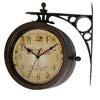
|
CONNECTIONS
|
IDAHO
ITD
HOME
IDAHO DMV
ITD NEWS
HIGHWAY
SAFETY
IDAHO STATE
POLICE
TRAVEL SERVICES
STATE OF IDAHO
NATIONAL
AASHTO
AAMVA
AAA of IDAHO
FEDERAL HIGHWAYS
FEDERAL AVIATION
IDAHO STATE POLICE
NHTSA
NTSB
TRB
U.S. DOT
Idaho
Transportation
Department
Public Affairs Office
P.O. Box 7129
Boise, ID 83707
208.334.8005
Fax: 208.334.8563
Email

Time
to reclaim your lost hour of sleep
Remember that hour of sleep you begrudgingly donated last spring when most of the nation moved to Daylight Saving Time? The time to reclaim it is in the predawn hours this Sunday – at exactly 2 a.m. – when we set clocks back one hour and revert to standard time.
 For
those less inclined to interrupt their slumber, changing all household
and vehicle clocks can be accomplished Saturday night before retiring
to bed. And while tinkering with time, this weekend is an ideal opportunity
to check the batteries in home smoke alarms.
For
those less inclined to interrupt their slumber, changing all household
and vehicle clocks can be accomplished Saturday night before retiring
to bed. And while tinkering with time, this weekend is an ideal opportunity
to check the batteries in home smoke alarms.
The practice of altering time was formally introduced during World War I as a way of saving energy for war production by taking advantage of the later hours of daylight between April and October, according to the on-line resource About.com. The federal government resumed the use of Daylight Saving Time during World War II.
Except for those mandatory shifts during the two wars, states and communities had the option of alternating between standard and daylight saving time each year. Congress standardized the length of Daylight Saving Time in 1966, prescribing an official start and end date for the observance. By choice, Arizona, Hawaii, part of Indiana, Puerto Rico, the U.S. Virgin Islands and American Samoa do not participate in the twice-yearly time change.
 “The
change to Daylight Saving Time allows us to use less energy in lighting
our homes by taking advantage of the longer and later daylight hours,”
according to About.com.
“The
change to Daylight Saving Time allows us to use less energy in lighting
our homes by taking advantage of the longer and later daylight hours,”
according to About.com.
If six-and-a-half months is good, wouldn’t seven-and-a-half be even better?
Congressional delegates apparently think so.
Last summer they voted to extend Daylight Saving Time by adding a month to the spring exercise. No changes will occur next year, but beginning in 2007 participating states and regions will advance the clock one hour in March instead of April.
There is a simple, time-honored way of honoring the time change: Spring forward (move the clock forward one hour in the spring) and fall back (move it back in the fall). Still confused? The following chart should help:
Year
|
Spring
Forward |
Fall
Back |
| 2006 | 2 a.m. April 2 | 2 a.m. Oct. 29 |
| 2007 | 2.a.m. March 11 | 2 a.m. Nov. 4 |
| 2008 | 2 a.m. March 9 | 2 a.m. Nov. 2 |
| 2009 | 2 a.m. March 8 | 2 a.m. Nov. 1 |
| 2010 | 2 a.m. March 14 | 2 a.m. Nov 7 |
| 2011 | 2 a.m. March 13 | 2 a.m. Nov. 6 |